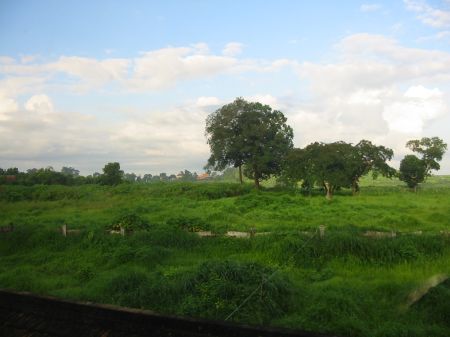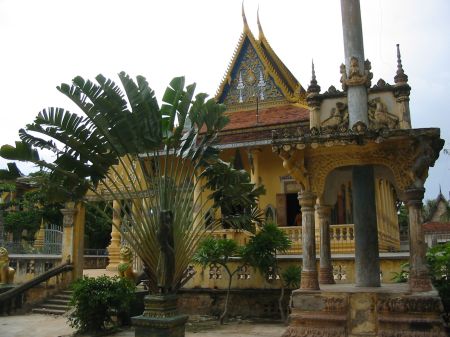This is Sunday. Initially the plan was to go with the moto driver/tourism student to Kampot, which is almost 200 km from Phnom Penh at the sea. This would have been a challenging thing to do on one day, but challenges are what we were looking for anyway.
However, the plan did not materialize. I gave my passport to the headquarter for visa extension and it is currently with I do not know which corrupt ministry. I knew that ‘lucky! lucky!’, the Chinese company where I usually rent a moto, does require its customers to leave their passports with them as some sort of security. However, when I came here last time they accepted my ID card and I had no reason to believe they would not do so this time. However, they did not accept it. I assume this is sort of related to the election. I read in the newspaper that many moto rental businesses have put their moto to save places. They are afraid that they loose their assets as soon as post-election riots start. This is exactly what happened after the last election. I realized that most of ‘lucky! lucky!’s motos are in fact not in the shop. I tried to convince them to give me a moto but I failed. So we tried several things, including trying to get my passport from the headquarter, which failed, too.
It was almost lunchtime when we had to face the fact that we would not get motos today. However, my co-traveler got a moto, which is however not a heavy duty one. Due to that and the fact that halve of the day was already over we had to settle for something less challenging than Kampot.
So we decided to visit the Mekong Islands. This is only a few kilometer to the northeast from Phnom Penh. I took the following picture when we passed the so-called Japanese Bridge in the north of the city, close to the French Embassy and Funcinpec headquarters.

This is another petrol station of the notorious company Sokimex. Although this is outside Phnom Penh they seem to be concerned about riots. Those fences in front of the truck can be quickly employed to prevent demonstrators from entering. I observed that any Sokimex station is secured with those fences during the night.
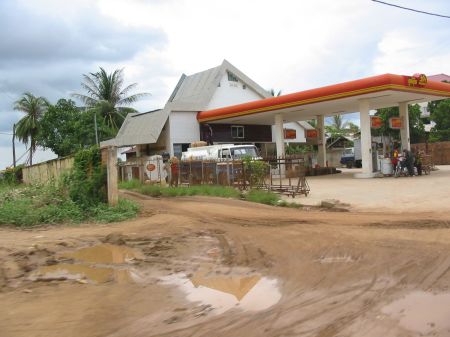
This is the place were the ferry to the Mekong Islands leaves. It is only about 15 km from Phnom Penh, shortly before one reaches Khady Chah. I have seen those large wooden boats very often. Mostly they seem to be in use to transport timber and other agricultural and forest products from the provinces to the capital.

Most of those people seem to live on one of the islands. I assume they went with some goods to the market in Phnom Penh in the morning and am on their way back home.
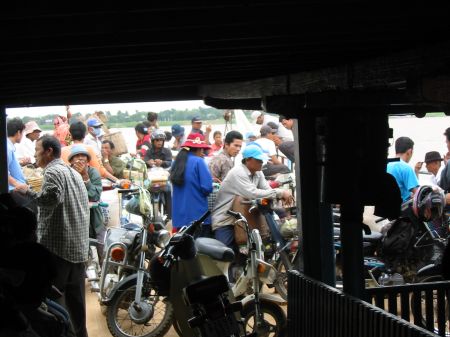
This is when the ferry arrives at the island. There is some turbulence when passengers try to leave the ferry while others try to get on.

This is how the road looks most of the time.

Of course we found a pagoda, too.

I got the impression that foreigners do not come here very often. Those youngsters seemed to be pretty amazed just by my sight.

Much of those islands seem to be covered with plantations of mostly bananas and papaya. I heard those farmers can achieve a good price on the urban market particularly with papaya.

This is when a short shower of rain hits us. However, after few minutes it is over.
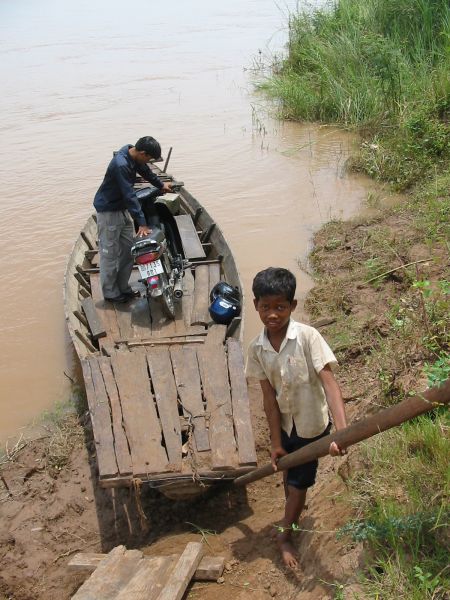
This island was rather small and we started to look for the next one. We found this guy who offered to give us a lift to the other bank.


We kept driving for some time. However, after we passed a small bridge the road turned very muddy. It became increasingly difficult to drive the moto with two people on this road. After we almost fell a few times and got pretty dirty we decided to continue walking. However, even that turned out to be quite difficult. Some villagers told us that the road is becoming worse further down the way. So we changed our mind and decided to drive back to the ferry and travel to another destination.
This is when we pass the bridge on the way back. I felt sorry for those guys on the moto. They were just two as well but they had loaded their moto with huge sacks of something that seems to be quite heavy. After I saw the road a few hundred meters from here I do not think they will make it without falling and getting very dirty.
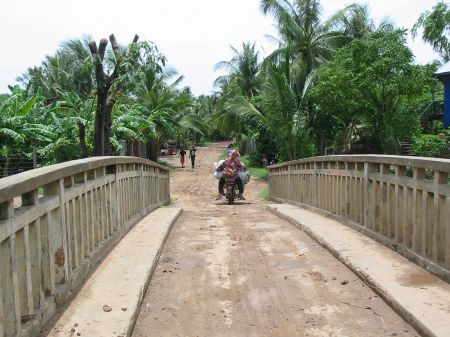
The ferry was at the other bank and we had some time to spend before we could pass the river. So we got us a soft drink at this place. We got into some conversation with local people. Later a woman appeared offering all sorts of hand woven scarves made of silk and cotton. I learned that making one scarf takes her about one week. Although I really do not have much use for it I bought a cotton one (3$) because I felt after she showed me all those products I cannot just refuse. My co-traveler is occupied with cleaning his clothes from the nasty ride.
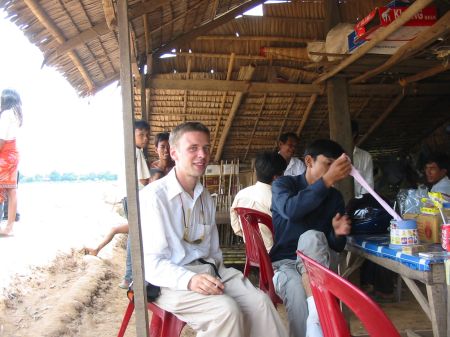
This is when the ferry finally arrives.
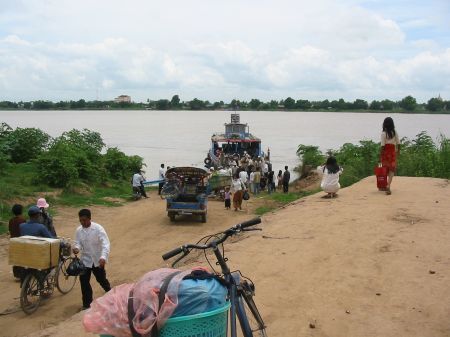
This is when we arrive back in Phnom Penh and pass the Japanese bridge. A number of speed boats are waiting at the bank.

Those are the shacks of some fishermen. From what I have seen so fare those people are likely to be ethnic Vietnamese or Muslim Cham.
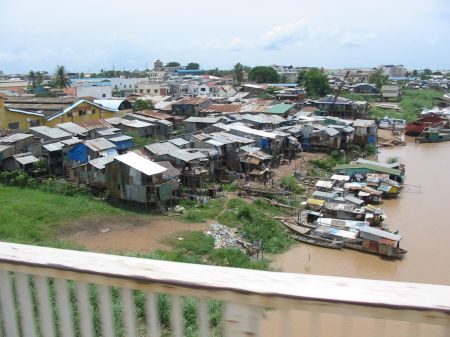
Since it was only early afternoon we decided to visit Kieng Svay as well. In order to do so we have to pass Phnom Penh and cross the Mekong again at the bridge in the south of Phnom Penh. Kieng Svay is a place where mostly local people hang out for recreation. I have been there before, but alone and only for a short time.
This is in front of Funcinpec headquarters. There are three boys of about 14 years traveling on a moto. This is quite a common sight. Frequently I see children (yes, girls as well) of hardly 12 years traveling with some routine and not exactly slow on all sorts of motos.

Railway Station.

This is how living chickens are transported.

There is still significant police presence, here at Hun Sen Park.

Since our moto was pretty dirty my co-traveler decided to give it a wash. We went to this place, where mostly women work really hard. The price for the quite extensive washing service is just about $0.125.

This is on national road number one with direction to Saigon.

I provided a picture of this construction side earlier. This will be by fare the biggest pagoda I have ever seen.

Finally we made it to this place close to Kieng Svay. This is one of the recreation destinations for (better of) urban Cambodian people. There are beautiful flowers and plants as well as good numbers of all sorts of birds all over the compound. It is located about 20 km outside Phnom Penh. Families come here to picnic in those huts close to the water. Some people were fishing. For some reasons I liked the place.


We spend about two hours and had some food. Than it started raining heavily. And there was no indication that the rain would stop anytime soon. We waited for quite some time. When it started getting dark and was still raining we decided to kick of and drive home.
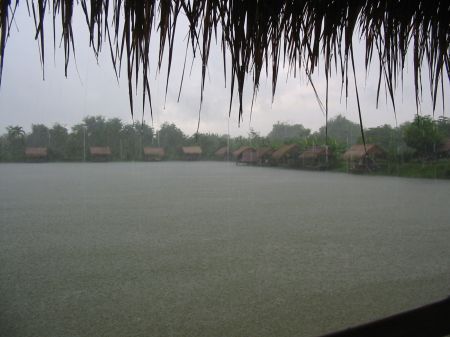
Co-traveler looks sort of tired for some reasons.

However, it was not raining as bad anymore. I was lucky to sit on the back of the moto partly protected from getting wet by the back of the driver.
Continue reading Mekong Islands, Kieng Svay
